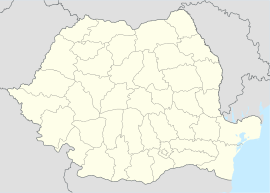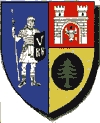world.wikisort.org - Romania
Blaj (Romanian pronunciation: [blaʒ]; archaically spelled as Blaș; Hungarian: Balázsfalva; German: Blasendorf; Transylvanian Saxon: Blußendref) is a city in Alba County, Transylvania, Romania. It has a population of 20,630 inhabitants.
Blaj | |
|---|---|
Municipality | |
 Greek-Catholic Cathedral | |
 Coat of arms | |
 Location in Alba County | |
 Blaj Location in Romania | |
| Coordinates: 46°10′31″N 23°54′52″E | |
| Country | Romania |
| County | Alba |
| Government | |
| • Mayor (2020–2024) | Gheorghe-Valentin Rotar[1] (PNL) |
| Area | 98.93 km2 (38.20 sq mi) |
| Elevation | 260 m (850 ft) |
| Population (2011)[2] | 20,630 |
| • Density | 210/km2 (540/sq mi) |
| Time zone | EET/EEST (UTC+2/+3) |
| Postal code | 515400 |
| Area code | (+40) 02 58 |
| Vehicle reg. | AB |
| Website | www |
The landmark of the city is the fact that it was the principal religious and cultural center of the Romanian Greek-Catholic Church in Transylvania.
History
Blaj is first mentioned in 1271 as Villa Herbordi, after the deed of a Count Herbod.[3][4] In 1313, the domain passed to Herbod's son Blasius Cserei and the town was mentioned as Blasii. Started as a hamlet for the twenty families of servants of the noble's court, it was awarded town status on May 19, 1737.
Blaj is the principal religious and cultural center of Greek Catholics in Transylvania. At 27 October 1687 begins the history of the Romanian Church United with Rome, Greek-Catholic, history directly connected to the history of the town Blaj. It all started at the end of the treaty through which Transylvania was entering under the protection of Austria, renouncing the protection of the Turkish Empire.[citation needed]
The first public school in Romanian was established in Blaj in 1754. Blaj was the first place to have Romanian written with Latin alphabet instead of Cyrillic in which it had traditionally been written. Blaj was also a center for the Romanian Age of Enlightenment, being the founding site of the Transylvanian School that promoted the Roman cultural heritage of the Romanians. Thus Blaj gained the nickname "The Little Rome",[5] as Romania's national poet Mihai Eminescu called it.
In 1848, Câmpia Libertății in Blaj was where over 40,000 Romanians met to protest Transylvania becoming a part of Hungary, holding that the lands would be stolen from them.[6]
Geography
Blaj lies at the confluence of the Târnava Mare and Târnava Mică rivers, where they form the Târnava River. It is located 39 km (24 mi) northeast of the county seat, Alba Iulia, in a renowned wine-growing region.
Climate
Blaj has a humid continental climate (Cfb in the Köppen climate classification). The city has a continental temperate climate, characteristic for the Transylvanian Plateau, with moderate precipitations of around 550 mm/m2.
| Climate data for Blaj | |||||||||||||
|---|---|---|---|---|---|---|---|---|---|---|---|---|---|
| Month | Jan | Feb | Mar | Apr | May | Jun | Jul | Aug | Sep | Oct | Nov | Dec | Year |
| Average high °C (°F) | 2.3 (36.1) |
5.1 (41.2) |
10.3 (50.5) |
16.2 (61.2) |
20.8 (69.4) |
24.1 (75.4) |
26.1 (79.0) |
26.3 (79.3) |
21.1 (70.0) |
15.5 (59.9) |
9.6 (49.3) |
3.5 (38.3) |
15.1 (59.1) |
| Daily mean °C (°F) | −1.6 (29.1) |
0.6 (33.1) |
5 (41) |
10.8 (51.4) |
15.7 (60.3) |
19.3 (66.7) |
21.2 (70.2) |
21.3 (70.3) |
16.2 (61.2) |
10.5 (50.9) |
5.1 (41.2) |
−0.1 (31.8) |
10.3 (50.6) |
| Average low °C (°F) | −5 (23) |
−3.3 (26.1) |
0 (32) |
5 (41) |
10.1 (50.2) |
14 (57) |
15.9 (60.6) |
16.1 (61.0) |
11.5 (52.7) |
6.1 (43.0) |
1.6 (34.9) |
−3 (27) |
5.7 (42.4) |
| Average precipitation mm (inches) | 29 (1.1) |
27 (1.1) |
37 (1.5) |
56 (2.2) |
75 (3.0) |
84 (3.3) |
76 (3.0) |
56 (2.2) |
54 (2.1) |
43 (1.7) |
33 (1.3) |
36 (1.4) |
606 (23.9) |
| Source: https://en.climate-data.org/europe/romania/alba/blaj-44396/ | |||||||||||||
Demographics
| Year | Pop. | ±% |
|---|---|---|
| 1930 | 4,618 | — |
| 1948 | 6,641 | +43.8% |
| 1956 | 8,731 | +31.5% |
| 1966 | 15,775 | +80.7% |
| 1977 | 20,826 | +32.0% |
| 1992 | 22,425 | +7.7% |
| 2002 | 21,819 | −2.7% |
| 2011 | 20,630 | −5.4% |
| Source: Census data | ||
Ethnicity
- Romanians - 16,779 (83.78%)
- Hungarians - 1,305 (6.51%)
- Romani - 1,850 (9.23%)
- Germans - 45 (0.22%)
By Religion
- Romanian Orthodox - 14,784 (71.19%)
- Greek-Catholic - 2,732 (13.24%)
- Roman Catholic - 744 (3.58%)
- Reformed Church - 985
- Baptist - 408
- Pentecostal - 220
Government
The city administers eight villages: Deleni-Obârșie (Obursatanya), Flitești, Izvoarele (until 1960 Ciufud; Csufud), Mănărade (Monora), Petrisat (Magyarpéterfalva), Spătac (Szászpatak), Tiur (Tűr) and Veza (Véza).
Education
The city has several high schools, including the Inochentie Micu Clain National College, the Ștefan Manciulea Technological High School, and the Sfântul Vasile cel Mare Greek-Catholic Theological High School.
Attractions
The castle of the Bethlen dynasty is a popular tourist site near Blaj. Other sights worth visiting include the Metropolitan Palace, the Holy Trinity Cathedral, the "Buna Vestire" Monastery, the Greeks' Church, the "Liberty Field", and Avram Iancu's oak.
Twin towns — Sister cities
Blaj is twinned with:
 Allschwil
Allschwil Morlanwelz
Morlanwelz Recanati
Recanati
Natives
- Tiberiu Bărbulețiu (born 1963), politician
- Silviu Bindea (1912–1992), footballer
- Matei Boilă (1926–2015), politician, Greek-Catholic priest
- Bogdan Cistean (born 1986), footballer
- Sonia Colceru (born 1934), volleyball player
- Ferenc Csentery (1937–2014), abstract metal sculptor
- Doina Ivănescu (1935–1996), volleyball player
- Bogdan Jica (born 2000), footballer
- Nicolae Linca (1929–2008), welterweight boxer
- Daniel Lupașcu (born 1981), footballer
- Ioan Simu (1875–1948), Greek-Catholic priest and politician
- Ioan Suciu (1907–1953), bishop of the Greek-Catholic Church
- Daniel Tătar (born 1987), footballer
- Samuil Vulcan (1758–1839), bishop of the Greek-Catholic Church
See also
- Bethlen Castle
- Câmpia Libertății
References
- "Results of the 2020 local elections". Central Electoral Bureau. Retrieved 6 June 2021.
- "Populaţia stabilă pe judeţe, municipii, oraşe şi localităti componenete la RPL_2011" (XLS). National Institute of Statistics.
- Mallows, Lucy; Abraham, Rudolf (26 November 2012). Transylvania. ISBN 9781841624198.
- "Archiv des Vereins für Siebenbürgische Landeskunde". 1848.
- "Blaj or "Little Rome", as Eminescu called it". AGERPRESS - the Romanian National News Agency. June 18, 2014. Retrieved July 7, 2018.
- Stoica, Vasile (1919). The Roumanian Question: The Roumanians and their Lands. Pittsburgh: Pittsburgh Printing Company. p. 23.
External links
На других языках
[de] Blaj
Blaj (.mw-parser-output .IPA a{text-decoration:none}blaʒ, deutsch Blasendorf, ungarisch Balázsfalva) ist eine rumänische Stadt im Kreis Alba in der Region Siebenbürgen.- [en] Blaj
[ru] Блаж
Блаж (рум. Blaj, венг. Balázsfalva) — город в Румынии, в жудеце Алба. В XVIII—XIX вв. город являлся важным культурным центром для румын Трансильвании, сыграв значительную роль в формировании современного румынского языка и национального самосознания румынской нации. В Блаже был издан первый учебник грамматики румынского языка, а в 1754 году была открыта первая школа с преподаванием на румынском языке.Другой контент может иметь иную лицензию. Перед использованием материалов сайта WikiSort.org внимательно изучите правила лицензирования конкретных элементов наполнения сайта.
WikiSort.org - проект по пересортировке и дополнению контента Википедии
